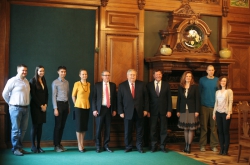Science in the memecube.
At the Geek Picnic, both young and renowned scientists talk about the latest trends in technology, science and arts. This time, lectures were split into four categories: technology, science, arts and Geek Me. At the same time, celebrities from the world of science made their presentations on the main stage. Apart from lectures and presentations, one could also watch technological shows at the Geek Picnic: there were robot battles, drone races, cosplay shows and other performances.
 ITMO University's interactive zone
ITMO University's interactive zone
This year marked the fourth time that ITMO actively participated in summer's largest technological festival - it organized a large interactive zone; at the entrance, any visitor could try innovative ice-cream developed at the university. The guests could also test the inventions created at the OLIMP laboratory and the university's FabLab: miniature demonstrations of smart home systems, the laser labyrinth concept, 3D printers created at the university and objects printed on them. Special setups were used to show how one can control fire intensity by using acoustic waves, how bioreactors work and how lasers can be used for engraving.

The Department of Engineering and Computer Graphics organized a VR and AR zone. The visitors could put on VR glasses and get a bird-eye view of St. Petersburg - a video prepared by the Video360Production Company. They’ve also presented a 3D game based on AR technologies. ITMO's eScience Research Institute demonstrated Russia's first urban development computer model which can be used to dynamically track the development of the newYuzhniy (South) satellite town.

"At ITMO's site, we've shown practically all of the activities our university has to offer. At the OLIMP Laboratory, school students can create and program robots. University students work on new technologies and scientific creativity projects at our FabLab. The Department of Engineering and Computer Graphics also shows the high level of projects our students are involved in. At our university's interactive zone everyone can find something to their liking. It is also important that at ITMO's site at the festival, the guests could try out our new functional foods. This way, we succeeded in completing one of our primary tasks - attracting the youth to the world of science and technology and introducing them to ITMO University's life," shares ITMO's Rector Vladimir Vasilyev.
 Vladimir Vasilyev
Vladimir Vasilyev
Geek Picnic's headliner was Richard Dawkins, evolutionary biologist and science writer. Mr. Dawkins developed the concept of a meme, and gave name to this cultural phenomenon. The scientist read a long lecture at the festival's main stage; ITMO.NEWS wrote down the main ideas.
 Richard Dawkins
Richard Dawkins
Richard Dawkins: the world of nature and the world of humans are both defined by economy
There's a term in economics - utility function. In human civilization that can be GDP or aggregated happiness. In the world of biology, there also are utility functions: survival of species, ecosystems, individuals and, surely, reproduction. Darwin was the first one to understand that survival is reproduction's main function. Yet, let's look deeper into that.
The only reason why parents care about their offspring is because they have genes that make them do so. Such genes are hereditary. Still, there are beings like termites. The termit queen is of great size in comparison with common termites, is totally helpless and is protected by worker termites. These termites are sterile. Yet, the gene that makes them protect the queen stays within their "brothers" and "sisters" that are born from the queen. In a sense, the termite colony is ancommon organism. The queen and the king are the reproductive body, worker termites play the role of an organism's other systems. Thus, one can say that the true utility function in biological economy is the survival of a gene, not the individual.

Another good example of that is the sex ratio in sea-elephants' colonies. In such colonies, they have alpha males that have harems. This way, about 72% of the males do not leave any offspring, and 4% of the males get 88% of females. If biological economy was planned economy, a good economist would've eliminated all single males. Yet, in fact the sex ratio of sea-elephants is 50% to 50%. Why is that? If we look at the issue with regards to genes, it all becomes clear, as this way, the possibility of a single male leaving offspring is increased. Even if only a single male from the offspring will reproduce, then he will leave many descendants, and particular genes will live on.

Economics is about survival in the conditions of limited resources. Let's imagine that the resource we lack is energy. How would one find energy for gene transfer? Most of the solar energy just heats things. Yet, some photons are used by solar batteries, both artificial and natural ones. Trees use light in photosynthesis processes. Then, the structured energy goes to herbivores, then - carnivores, and so on. In a forest, few photons reach the earth, so its always gloomy. So, the question is: why do trees grow tall? Trees would have generally profited if they could agree on growing no taller than a couple of meters - that would have been an economist's advice. Yet, imagine such a situation: all trees are low, but then a mutant emerges that grows taller. It gets more light, hence more resources. Other trees start to compete with it and grow taller with each generation. As result, the forest looks like a meadow on stilts, and much energy is spent on supporting these stilts. Thus, trees are a good example of ineffective competition in regards to planned economy.

In the end, the fastest to develop are genes push animals to evolve. Yet, there are certain peculiarities. For instance, one can tell about changes in climate by analyzing certain genes: some animals had thicker fur during certain periods of time, but such changes are slow, as climate change is different from the threat presented by a predator. The relationship between lions and antelopes is different from the interrelations between animals and weather. The lion wins if the antelope dies. At the same time, if the antelope escapes it decreases the chances of its enemy's survival. Thus, it is something like an evolutionary arms race. As in economics, animals have to "choose" what resources they are ready to spend on this arms race, which traits they need to develop and which - to sacrifice.

While predators develop more capabilities for killing, their prey also evolves. Although the prey aims to become more successful than other representatives of its species - they do not have to be "better" that the one chasing them, but just be faster than the others who are being chased.
 Richard Dawkin's signing session
Richard Dawkin's signing session
At the same time, this "arms race" is asymmetrical. The rabbit runs faster than the fox, as the two animals have different motivation. The rabbit runs in order to survive, and the fox runs in order to eat, so the resources they spend on developing the corresponding skills vary.
Other lectures: humanity's biological future, prostheses as part of one's outfit and horrors of psychology
During the Geek Picnic's first day, there were more than 25 different lectures on various topics ranging from science to art; from anthropology to artificial intelligence. Stanislav Drobyshevskiy, anthropologist and science writer, talked about humanity's biological future. Many researchers forecast that humans will stop evolving thanks to high technologies they use and may even lose some of their biological capabilities and functions. Yet, losing some trait is still evolutionary change!
 Stanislav Drobyshevskiy
Stanislav Drobyshevskiy
"There's an idea that when humans will have all the resources and amenities they need, they will focus on self improvement, on developing arts and science. Yet, in reality, when an organism has everything it needs, its future as a species is not that bright," comments the anthropologist.
He gave the example of beef tapeworm. This creature lives surrounded by food; because of that, it only has the digestive and reproductive systems - no locomotor system or anything like that. This can be the future that awaits us humans, as well. Some researchers already notice the first symptoms. For instance, in the last 25 years our brain has diminished more than it did over the last millenia. Our teeth become smaller and smaller. If we will once switch to liquid foods, we might no longer need muscles for chewing. Even now, many children are born with coalescent fingers on their feet, as these fingers no longer have any useful function.

"We may well become paridigitates in the future - who knows? We may even lose our nervous system, so we won't even feel anything about losing some of our functions," jokes the researcher.
Another of the festival's speakers, designer Nikita Replyanskiy, spoke about not so distant a future. He presented the concept that had to do with how prostheses and other similar devices change our capabilities and how will they be perceived in regards to design and fashion. Presently, people with prostheses often feel uncomportable about having to wear them. Also, most modern prostheses are a lot less functional than their older models, but few people would wear things like arm hooks now. This situation has to change.
 Nikita Replyanskiy
Nikita Replyanskiy
"When I want to buy sneakers, I can browse through several shops before buying them. Why can't a person who has to wear prostheses every day use them as means of self-expression? Surely, not everyone would like to do that, yet it has now become a trend," says the speaker.
As of now, only few new inventions took flight in this field; in essence, developers now face two tasks: to create prostheses and devices that will really help people and to make people want to use them.
People's opinions are really important in anything that has to do with promoting and introducting new inventions. This is why explaining science adequately is most important. For instance, when people hear about psychological experiments, they often imagine tormented patients and things like that. In reality, everything's different, notes Roman Tihonov, PhD student and staff member of the Psychology Department of Saint Petersburg State University. He explained how it happened that the public has developed a negative attitude towards psychologists who conduct experiments on people.

It all began with experiments conducted by Stanley Milgram at the Yale University in 1960-s. The psychologist wanted to understand: why could lots of people in the Nazi Germany execute inhuman orders during the Second World War? To do that, he gathered two groups of people. The first group - the ones being tested - were the "teachers". The second were the "students", who were actually the scientist's assistants. The "teachers" were to punish the students with electric charges should they fail at some task. They were told that the power level increased each time, and when the "student" told them they were in great pain (though they just acted as such), the experiment's head told the "teachers" to continue punishing them, upon his responsibility. It turned out that 65% of the experiment's participants continued to torture the "students", and only 12.5% of them stopped right after the students said they experience pain.
Later, the experiment was deemed unethical, as it traumatized the ones tested, twisted their values and brought mental harm. It was then that the ethical code of psychologists was created. Roman Tikhonov also reminded the festival's guests of the Stanford prison experiment that took place in 1970-s. Its participants were to take part in simulating a prison: some became guards and some - prisoners. The experiment went out of control and was canceled, as the participants became too immersed in their roles and started to show signs of psychological disorders. As of the present time, most psychological experiments go as following: a participant comes into an office where the scientists work; there, they play special games or solve tasks.

There will be even more interesting lectures during Geek Picnic's second day. The schedule can be seen on the event's website.





